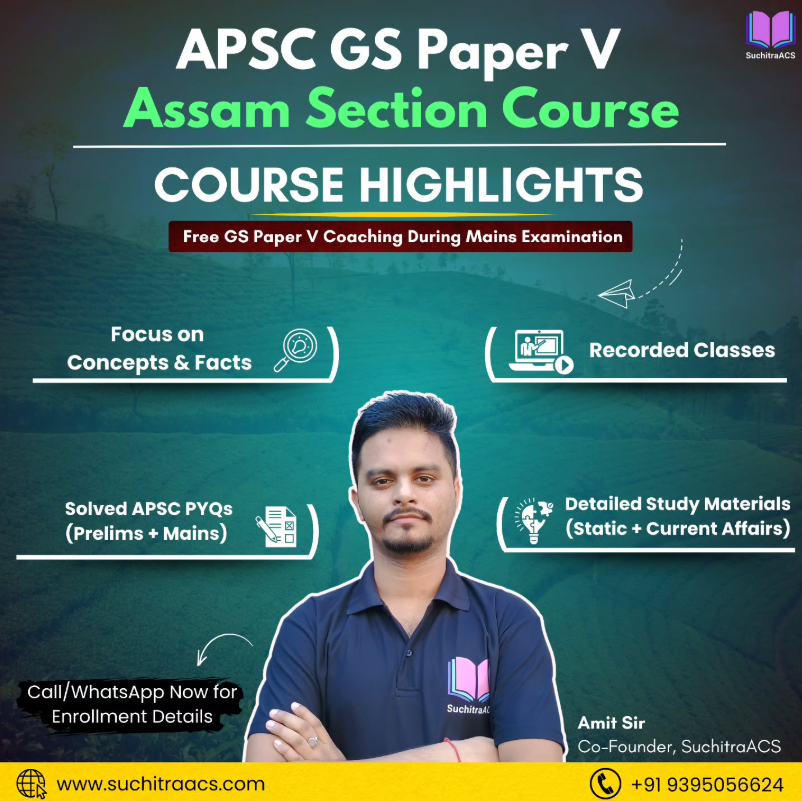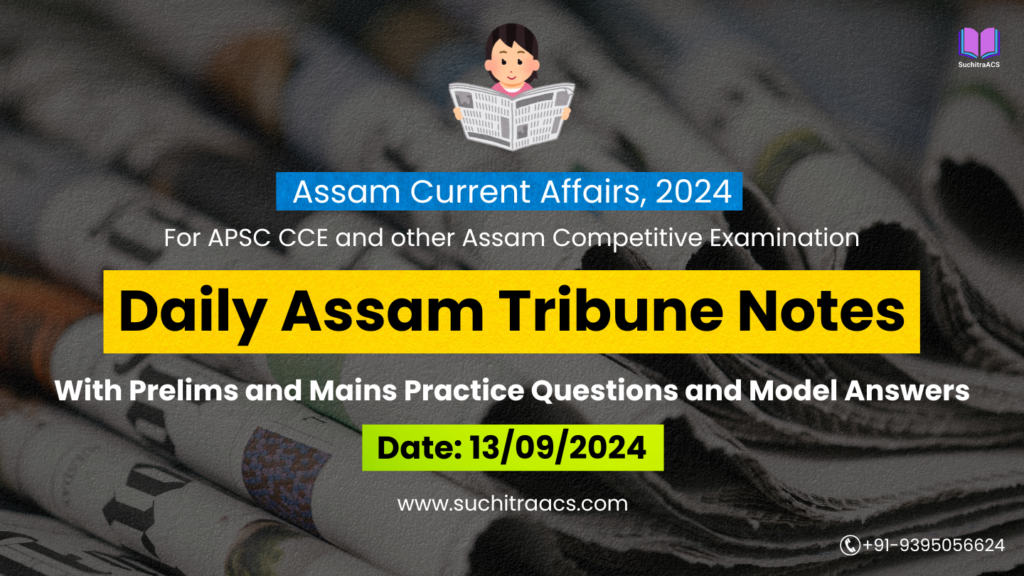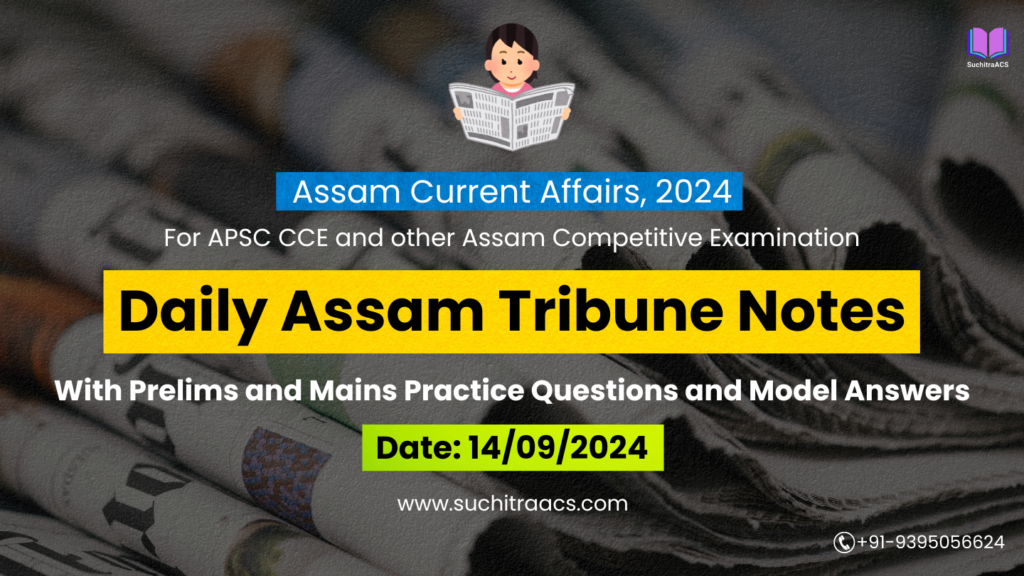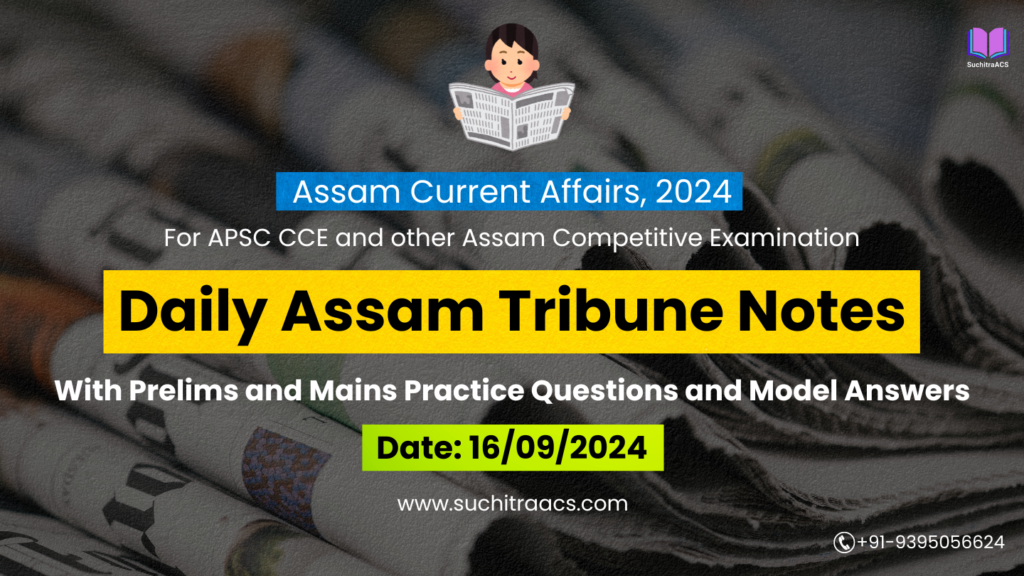APSC Current Affairs: Assam Tribune Notes with MCQs and Answer Writing (17/06/2025)
For APSC CCE and other Assam Competitive examinations aspirants, staying updated with current affairs is vital. This blog covers most important topics from the Assam Tribune today (17-06-2025). These issues are key for both APSC Prelims and Mains preparation, offering insights into the APSC CCE Syllabus.
✨ APSC CCE Online Coaching, 2026

🌧️ Drowning in Development: Guwahati’s Struggle with Flash Floods
📘 GS Paper 1: Urban Geography | Urbanisation & Infrastructure
📘 GS Paper 3: Disaster Management | Climate Change | Sustainable Development
📘 GS Paper 5 (APSC): Assam – Urban Issues | Floods & Infrastructure Planning
🔹 Introduction
Guwahati, Assam’s largest city and its commercial hub, is now synonymous with chronic flash floods, a seasonal urban disaster. Every monsoon, even short bursts of rainfall paralyse the city due to waterlogging, exposing systemic planning failures, rapid unregulated urbanisation, and poor drainage infrastructure. The article highlights the need for flood-resilient urban planning rooted in sustainability.
🔑 Key Highlights
| Issue | Description |
| Main Areas Affected | Chandmari, RG Baruah Road, Rukminigaon, Lokhra, Beltola, Zoo Road |
| Reasons for Flooding | Encroachment on wetlands, hill cutting, unplanned constructions |
| Natural Systems Lost | Draining beels, clogged streams, loss of green cover |
| Impact on Lives | Traffic jams, disruption to education, health hazards, property loss |
| Engineering Failures | Outdated drainage, lack of pervious surfaces, low elevation zones |
| Expert Suggestions | Advanced drainage, zoning, green buffers, rainwater harvesting |
🧠 Prelims Pointers
Flash Floods: Sudden urban flooding caused by rainfall >30mm/hr with poor drainage
Beels: Freshwater wetlands in Assam that naturally absorb excess rainwater
Pervious Concrete: Material that allows water to seep into ground; key to flood mitigation
Chatribari Beel: Once a bird habitat; now degraded due to urban encroachment
Urban Heat Island Effect: Exacerbated by reduced tree cover and impermeable concrete
📝 Mains Pointers
A. Causes of Guwahati’s Flood Vulnerability
| Cause | Description |
| Loss of Wetlands | Over 60% of Guwahati’s wetlands have vanished, blocking natural drains |
| Encroachment | Construction on flood plains and hill slopes, shrinking green zones |
| Unplanned Urban Growth | City expanded without a drainage masterplan post-capital shift from Shillong |
| Solid Waste in Drains | Garbage choking natural and stormwater drains |
| Lack of Climate-Resilient Infrastructure | Roads, footpaths don’t allow water infiltration |
B. Recommendations from Urban Experts
Identify and zone Flash Flood Prone Areas (similar to earthquake zoning)
Use permeable pavements, bioswales, and vegetated buffers
Design school grounds and stadiums as temporary flood retention zones
Adopt green roofs, rain gardens, and stormwater harvesting
Revive and protect beels as natural flood buffers
C. Challenges in Implementation
| Challenge | Example/Explanation |
| Land Politics | Resistance from builders and encroachers in wetland zones |
| Inter-agency Coordination | GMDA, GMC, PWD, and IWT often work in silos |
| Funding Constraints | Drainage improvement requires capital-intensive infrastructure |
| Lack of Public Awareness | Low adoption of rainwater harvesting at household level |
📑 Relevant Policies & Reports
Assam Urban Flood Mitigation Plan (Draft)
Smart Cities Mission – Guwahati (includes urban flood resilience component)
AMRUT (Atal Mission for Rejuvenation and Urban Transformation)
Assam State Action Plan on Climate Change (SAPCC)
12th Five-Year Plan (Urban Development Chapter) – prioritised stormwater infrastructure
🧭 Way Forward
| Domain | Policy Direction |
| Urban Planning | Integrate micro-level flood zoning into Master Plans |
| Legal Framework | Strengthen Wetland Protection Act & impose fines on illegal construction |
| Technology Use | GIS mapping of flood-prone pockets, real-time flood alert systems |
| Public Participation | Form RWAs to manage local drain maintenance and rainwater harvesting |
| Nature-Based Solutions | Invest in urban forestry, beel rejuvenation, and riverbank greening |
🧩 Conclusion
Guwahati’s battle with flash floods is a wake-up call for climate-resilient urbanisation. Beyond infrastructure, it demands a civic and ecological reimagining of development where wetlands, trees, and water-smart solutions form the new blueprint. If ignored, the costs of floods will multiply, affecting lives, economy, and the sustainability of Assam’s growth engine.
🎓 Assam’s Teacher Eligibility Test (TET) Reforms: Shaping Quality in School Education
📘 GS Paper 2: Education | Governance | Government Schemes
📘 GS Paper 5 (APSC): Assam – School Education | Public Recruitment | Policy Implementation
🔹 Introduction
The Assam Government has announced a set of major reforms to the Teacher Eligibility Test (TET) to improve the quality of school education, align recruitment with NEP 2020, and address long-standing challenges in teacher deployment, absenteeism, and accountability. These include new eligibility norms, exam pattern revisions, and stricter monitoring of TET-certified teachers.
🔑 Key Reform Highlights
| Policy Decision | Description |
| 📘 New TET Structure | Tiered difficulty levels for LP, UP, and Secondary levels |
| 🎓 Eligibility Tightened | Higher minimum qualifications for science/maths and tribal region posts |
| 📈 Performance-Based Renewal | TET certificate validity linked to periodic school inspection reports |
| 🕵️♂️ Verification Mechanism | QR-code–based digital TET certificates to reduce forgery |
| 🧑🏫 Teacher Allocation Reform | Rationalisation of surplus teachers in urban areas to rural vacancy zones |
| 🎯 Exam Pattern Revamp | More weightage to pedagogy, classroom ethics, and NEP-relevant modules |
🧠 Prelims Pointers
TET: Mandatory qualifying exam for appointment as a teacher under the Right to Education Act, 2009
NEP 2020: Calls for teacher recruitment based on merit, diversity, and continuous assessment
LP and UP: Lower Primary (Classes 1–5), Upper Primary (Classes 6–8)
DARPAN Portal: Assam’s digital platform for school staff and performance monitoring
QR-Coded Certificates: Recently introduced by CBSE and now extended to state TET exams
📝 Mains Pointers
A. Why TET Reform Was Needed in Assam
| Issue Area | Description |
| Quality vs Quantity | ~1.2 lakh TET-qualified candidates, but teacher absenteeism remains high |
| Tribal & Remote Gaps | Unfilled posts in Bodo, Karbi, and tea garden belts |
| Credential Forgery | Reports of fake certificates in 2021–2023 |
| Curriculum Disconnect | Old TET pattern lacked NEP integration (child psychology, ICT tools) |
| Deployment Inequity | Teacher clustering in Guwahati vs shortage in interior districts |
B. Expected Impact of the Reforms
📊 Merit-based Recruitment: Ensures only deserving candidates qualify
🏫 Rural Outreach: Incentivised postings to underserved zones
🧠 Professionalisation of Teaching: Treats teachers as trained professionals, not just staff
🌱 Child-Centric Learning: Encourages pedagogy aligned with multi-lingual, activity-based NEP norms
🔐 Digital Credentialing: Makes records tamper-proof and easily verifiable
C. Challenges to Implementation
| Challenge | Explanation |
| Political Pressure | Risk of lobbying in rationalisation or recruitment lists |
| Infrastructure Gaps | Poor facilities in schools where teachers may be transferred |
| Language & Diversity | Test design needs to respect tribal languages and pedagogical needs |
| Monitoring Capacity | Weak inspection system could fail to assess actual performance |
| Teacher Resistance | Pushback from existing workforce over changes in certificate validity |
📑 Relevant Policies & Reports
Right to Education Act, 2009 – mandates minimum teacher qualification via TET
NEP 2020 – Chapter 5 – Teacher Education and Recruitment
Assam Education (Provincialisation) Rules, 2021
National Curriculum Framework for Teacher Education (NCFTE)
NITI Aayog’s School Education Quality Index (SEQI)
🧭 Way Forward
| Focus Area | Strategy |
| Pre-Service Training | Mandatory pedagogy internships and tribal language modules |
| Incentivised Postings | Offer rural posting bonus, housing, or fast-track promotions |
| Transparent Posting Portal | GIS-based platform to track vacancies and teacher placement |
| Continuous Learning | Refresher courses every 5 years as part of TET renewal |
| Stakeholder Dialogue | Include teacher unions and civil society in design and rollout |
🧩 Conclusion
The reform of Assam’s TET system is a welcome step towards ensuring quality education for every child, especially in rural and tribal areas. For it to succeed, the state must match policy ambition with administrative integrity, teacher support, and genuine decentralisation.
🩺 Medical Colleges in Assam Face Faculty Shortage: Challenges in Public Health Education
📘 GS Paper 2: Health | Education | Government Policies
📘 GS Paper 3: Infrastructure – Health Sector
📘 GS Paper 5 (APSC): Assam – Health Infrastructure | Medical Manpower Crisis
🔹 Introduction
As Assam continues its ambitious expansion of medical colleges across districts, a growing concern is emerging: acute shortage of qualified faculty and specialist doctors, especially in newly established institutions like Dhubri, Nagaon, and Lakhimpur. Despite the push for decentralised medical education, infrastructure is outpacing human resource availability, putting at risk both MBBS training quality and public health service delivery.
🔑 Key Highlights
| Issue Area | Details |
| ❌ Faculty Shortage | Over 35% shortfall in key departments: anatomy, surgery, paediatrics |
| 🧪 Labs & Teaching Infra | Inadequate equipment, simulators, and PG teaching hospitals |
| 🧑🏫 Retention Challenge | Senior doctors reluctant to join peripheral colleges |
| 🏥 Service Impact | Disruption in OPD, emergency and rural referral services |
| 🧑🎓 Student Concerns | Quality of education and internships compromised |
| 🎯 Govt Response | Plan to bring in faculty from private colleges on deputation basis |
🧠 Prelims Pointers
NMC (National Medical Commission): Regulates medical colleges and faculty norms in India
Assam Medical Colleges Expansion Plan (2021–2026): 12+ new colleges including in Barpeta, Kokrajhar
Faculty-to-Student Ratio (UG): NMC mandates 1:10 for clinical departments
District Hospital Upgradation Norms: For conversion into teaching hospitals (100+ bed capacity, OPD/OT labs)
NEET-PG Quota: Assam reserves seats for bonded rural service, but enforcement is weak
📝 Mains Pointers
A. Importance of Medical College Expansion in Assam
Fulfils regional healthcare equity and addresses urban-rural doctor divide
Reduces outmigration of medical aspirants to other states
Boosts local economy and infrastructure
Increases availability of doctors for government health schemes (e.g. PM-JAY, Mission Indradhanush)
B. Faculty & HR Challenges in Assam’s Medical Sector
| Challenge | Description |
| Lack of Senior Doctors | Experienced professors prefer Guwahati or private colleges |
| Postgraduate Gaps | New colleges lack PG departments to create internal faculty pipelines |
| Weak Incentives | No special pay, housing, or tenure track for rural postings |
| Regulatory Bottlenecks | Delay in MCI/NMC inspection clearances due to staffing gaps |
| Bond Enforcement | MBBS students evade rural service bonds due to lax monitoring |
C. Consequences of Faculty Deficiency
NMC de-recognition risk for colleges with persistent non-compliance
Decline in clinical exposure and skill development for MBBS students
Weakens Assam’s ability to respond to pandemics and rural health crises
Referral burden on GMCH and Dibrugarh hospital increases
Compromises Assam’s public health delivery in maternal & child health, NCDs
📑 Relevant Policies & Reports
National Medical Commission Act, 2019
Assam Health Vision 2030
NEP 2020 – Medical Education Integration
15th Finance Commission Grants for Health Infrastructure
NITI Aayog Report on Medical College Density (2021)
🧭 Way Forward
| Strategy Domain | Action Points |
| HR Development | Launch Assam-specific Medical Faculty Fellowship Program |
| Incentivised Postings | Rural tenure linked to PG admission or promotion in Health Dept |
| Technology Use | Virtual classrooms and telemedicine for smaller colleges |
| Faculty Sharing Model | Create rotating pools of visiting professors from apex institutions |
| Medical Education Reform | Encourage DNB courses and tie-ups with district hospitals for PG capacity |
🧩 Conclusion The expansion of medical colleges is a landmark public health investment, but without faculty, it risks becoming a hollow infrastructure milestone. Assam must urgently address human capital bottlenecks to ensure that its medical education ambitions translate into lasting healthcare dividends.soul, linking identities through stories.
APSC Prelims Practice Questions
✅ Topic 1: 🌧️ Guwahati Urban Flooding
1. Which of the following are major causes of urban flooding in cities like Guwahati?
- Encroachment on wetlands
- Inadequate drainage system
- Use of pervious concrete
- Hill cutting and unregulated construction
Select the correct code:
A. 1, 2 and 4 only ✅
B. 1 and 3 only
C. 2, 3 and 4 only
D. 1, 2, 3 and 4
🧠 Explanation:
- Pervious concrete helps in infiltration, thus reducing flooding, so statement 3 is incorrect.
- The other three (wetland encroachment, poor drainage, hill cutting) are correct.
2. Which of the following wetlands is historically known to absorb floodwaters in Guwahati?
A. Maguri Beel
B. Deepor Beel ✅
C. Son Beel
D. Urpad Beel
🧠 Explanation:
Deepor Beel is a Ramsar site located on the western fringe of Guwahati and is critical to flood mitigation.
✅ Topic 2: 🎓 Assam Teacher Eligibility Test (TET) Reforms
3. Which of the following statements about the Teacher Eligibility Test (TET) in India is correct?
A. It is optional for appointment in government schools.
B. It is mandatory under the Right to Education Act, 2009. ✅
C. It is conducted only by the Central Government.
D. It is valid for only one year across all states.
🧠 Explanation:
TET is mandatory under the RTE Act, and states conduct their own TET alongside the Central TET (CTET).
4. The Assam TET reforms recently included which of the following features?
- Digital QR-code based certificates
- Performance-based renewal of validity
- Reservation for tribal language teachers
- Common eligibility for private schools only
Select the correct answer:
A. 1 and 2 only ✅
B. 1, 2 and 3 only
C. 2, 3 and 4 only
D. 1, 3 and 4 only
🧠 Explanation:
- QR-code based digital certification and performance-based validity are confirmed reforms.
- There is no specific reservation for tribal language teachers in this reform (though tribal area deployment was mentioned).
- TET applies to government schools primarily.
✅ Topic 3: 🩺 Medical Faculty Shortage in Assam
5. According to NMC norms, what is the minimum faculty-to-student ratio for MBBS programs in India (UG level clinical departments)?
A. 1:5
B. 1:10 ✅
C. 1:15
D. 1:20
🧠 Explanation:
As per the National Medical Commission, a minimum 1:10 faculty-to-student ratio is required for proper teaching and clinical training in undergraduate medical education.
6. Which of the following statements is true regarding the National Medical Commission (NMC)?
A. It is a constitutional body.
B. It replaced the Medical Council of India. ✅
C. It conducts the NEET-PG exam through CBSE.
D. It regulates paramedical and nursing courses in India.
🧠 Explanation:
The NMC Act, 2019, replaced the Medical Council of India (MCI) and regulates medical education and ethics. Nursing and paramedical education are regulated by other bodies.
Prasar Bharati, established by the Prasar Bharati Act, 1990, is India’s autonomous public broadcaster, which manages DD and AIR.
APSC Mains Practice Question
📝 Mains Question:
Q. “The recurring flash floods in Guwahati highlight the urban planning crisis in India’s rapidly growing cities.” Discuss the causes, consequences, and sustainable solutions for urban flooding with special reference to Guwahati.
📘 Model Answer
Introduction
Flash floods in urban areas like Guwahati, Assam’s largest city, have become a seasonal crisis. Even moderate rainfall now triggers massive waterlogging, traffic standstills, and infrastructure breakdown. These events expose the failure of urban systems to adapt to climate variability, unregulated expansion, and poor ecological governance. Guwahati represents a broader pattern seen across Indian cities, from Chennai to Mumbai.
Causes of Urban Flooding in Guwahati
| Cause | Explanation |
| Wetland Encroachment | Over 60% of Guwahati’s wetlands and beels (e.g., Deepor Beel, Chatribari Beel) have been filled for real estate development. |
| Unregulated Urbanisation | Construction on hill slopes and floodplains without proper zoning or EIA. |
| Drainage Infrastructure Failure | Outdated or clogged stormwater drains, many laid in the 1970s, can’t handle runoff. |
| Loss of Natural Outlets | Disruption of natural rivulets (e.g., Bharalu River) and lake systems. |
| Solid Waste Blockages | Garbage dumping into drains reduces flow and leads to backflow during rains. |
| Climate Change | Increased frequency of intense rainfall events due to shifting monsoon patterns. |
Consequences
A. Social and Economic Impact
- Disruption of daily life: Schools shut down, ambulances blocked, offices closed
- Financial losses: Property damage, shop closures, vehicle breakdowns
- Health hazards: Waterborne diseases, breeding grounds for dengue, cholera
B. Ecological Impact
- Loss of biodiversity in urban wetlands
- Groundwater recharge capacity reduced
- Urban Heat Island intensification due to loss of green buffers
Sustainable Solutions for Urban Flood Mitigation
| Solution Area | Recommendation |
| Urban Planning | Integrate flood zoning into the Guwahati Master Plan; demarcate wetlands and water-retention areas |
| Eco-sensitive Development | Restore beels and hill ecosystems; ban further hill-cutting and encroachment |
| Drainage System Overhaul | Use geospatial mapping and hydraulic modeling to redesign stormwater flow networks |
| Permeable Infrastructure | Promote pervious pavements, green roofs, bioswales, rain gardens |
| Community Engagement | Mobilize RWAs for decentralized waste management and rainwater harvesting |
| Institutional Coordination | Empower Guwahati Metropolitan Development Authority (GMDA) with clear authority and funds |
Case Studies / Best Practices
- Deepor Beel Buffer Proposal: Though currently stalled, the plan to create a conservation buffer could serve as a model
- Indore’s Swachh Infrastructure: Combines solid waste control with drain clearance campaigns
- Kochi’s Sponge City Initiative: Integrates natural water retention in new building codes
Conclusion
Guwahati’s annual waterlogging is not just a monsoon mishap—it is a governance failure rooted in flawed urbanisation. The city’s future depends on a shift from reactive flood response to proactive, climate-resilient infrastructure and land-use planning. Assam must balance growth with green logic to protect both its urban citizens and ecological foundations.technology, accountability, and grassroots involvement is essential to prevent energy from becoming a liability. Future growth must be cleaner, safer, and more people-centric.
✨ APSC CCE Courses, 2025-26 offered by SuchitraACS


🔔 Join Our WhatsApp Study Group!
For exclusive access to premium quality content, including study materials, current affairs, MCQs, and model answers for APSC CCE and other Assam competitive exams.
Click here to join: SuchitraACS Study WhatsApp Group
📚 Want to know more about SuchitraACS’s most affordable courses?
Click here to know more: SuchitraACS Courses for APSC CCE and Assam Competitive Examinations




